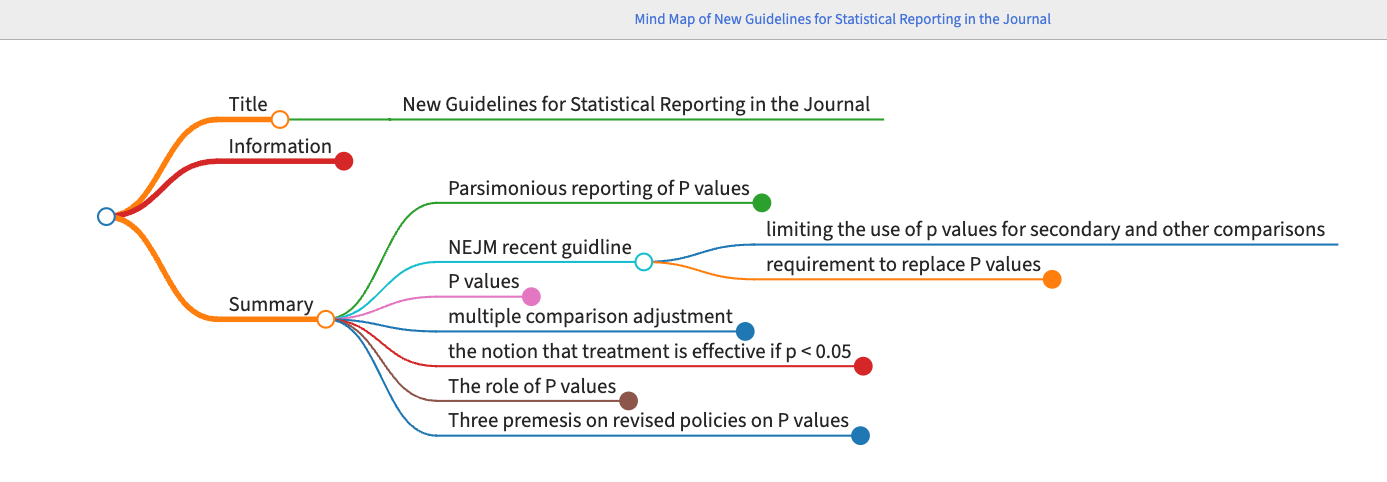New Guidelines for Statistical Reporting in the Journal
New Guidelines for Statistical Reporting in the Journal
Title
- New Guidelines for Statistical Reporting in the Journal
Information
- Link
- https://www.nejm.org/doi/full/10.1056/NEJMe1906559
- Citation
- Harrington, D., D’Agostino Sr, R. B., Gatsonis, C., Hogan, J. W., Hunter, D. J., Normand, S. L. T., … & Hamel, M. B. (2019). New guidelines for statistical reporting in the journal. New England Journal of Medicine, 381(3), 285-286.
- Topic
- Statisitcal reporting
- Medical journal
Summary
- Parsimonious reporting of P values
- e.g., VITAL trial
- two by two factorial, placebo controlled, randomized trial
- whether Vitimin D or omega 3 prevent cardiovascular disease or cancer
- 2 prespecified outcomes and
- 22 prespecified and other secondary outcomes
- only reported the hazard ratios and CI for the intervention effects for these outcomes
- e.g., VITAL trial
- NEJM recent guidline
- limiting the use of p values for secondary and other comparisons
- requirement to replace P values
- with estimates of effects or association
- and 95% confidence intervals
- when neither the protocol nor the statistical analysis plan has specified methods
- to adjust for multiplicity
- with estimates of effects or association
- P values
- how incompatible the observed data may be with a null hypothesis
- p < 0.05 implies that
- treatment effect or exposure association larger than that observed would occur less than 5% under a null hypothesis of no effect or association
- assuming no confounding
- type I error
- the null hypothesis is false when in fact it is true
- without adjustment for multiplicity,
- the probability of declaring a treatment difference when none exsists can be much higher than 5%
- do not represent the probability that the null hypothesis is false
- provide no information about
- the variability of an estimated association (its standard error)
- non-significant p values do not distinguish between group differences that are truely neglible and group differences that are noninformative becuase of large standard errors
- size of an effect or association
- multiple comparison adjustment
- is available
- to control the type I error probability in an anlysis when specified in the design of a study
- the notion that treatment is effective if p < 0.05
- reductionist view of medicine that does not always reflect reality
- The role of P values
- Well-designed randomized or observational study with primary hypothesis and prespecified method of analysis
- the significance level from that analysis is a reliable indicator of to which the observed data contradict a null hypothesis of no association between an invervention or an exposure and a response
- P values have a role in those decisions
- clinicians and regulatory agencies must make decisions about which treatment to use or to allow to be marketed
- Well-designed randomized or observational study with primary hypothesis and prespecified method of analysis
- Three premesis on revised policies on P values
- it is important to adhere to a prespecified analysis plan
- the use of statistical thresholds for claiming an effect or association should be limited to analysis for which the analysis plan outlined a method for controlling type I error
- the evidence about the benefits and harms of a treatment should include both point estimates and their margins of error
This post is licensed under CC BY 4.0 by the author.
